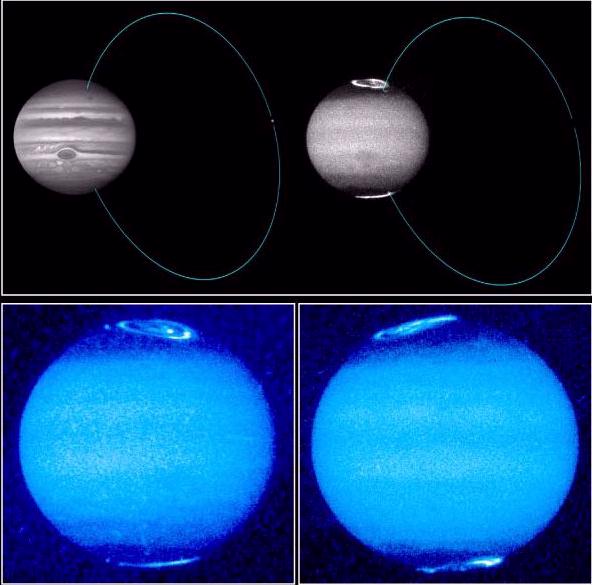

HUBBLE IMAGES REVEAL JUPITER'S AURORAS
EMBARGOED UNTIL: 4
P.M.(EDT) October 17, 1996
PHOTO NO.: STScI-PRC96-32 (or jupaur)
These images, taken by the Hubble Space Telescope, reveal changes in Jupiter's auroral emissions and how small auroral spots just outside the emission rings are linked to the planet's volcanic moon, Io. The images represent the most sensitive and sharply-detailed views ever taken of Jovian auroras.
The top panel pinpoints the effects of emissions from Io, which is about the size of Earth's moon. The black-and-white image on the left, taken in visible light, shows how Io and Jupiter are linked by an invisible electrical current of charged particles called a "flux tube." The particles - ejected from Io (the bright spot on Jupiter's right) by volcanic eruptions - flow along Jupiter's magnetic field lines, which thread through Io, to the planet's north and south magnetic poles. This image also shows the belts of clouds surrounding Jupiter as well as the Great Red Spot.
The black-and-white image on the right,
taken in ultraviolet light about 15 minutes later, shows
Jupiter's auroral emissions at the north and south poles. Just
outside these emissions are the auroral spots. Called
"footprints," the spots are created when the particles
in Io's "flux tube" reach Jupiter's upper atmosphere
and interact with hydrogen gas, making it fluoresce. In this
image, Io is not observable because it is faint in the
ultraviolet.
The two ultraviolet images at the bottom of the picture show how
the auroral emissions change in brightness and structure as
Jupiter rotates. These false-color images also reveal how the
magnetic field is offset from Jupiter's spin axis by 10 to 15
degrees. In the right image, the north auroral emission is rising
over the left limb; the south auroral oval is beginning to set.
The image on the left, obtained on a different date, shows a full
view of the north aurora, with a strong emission inside the main
auroral oval.
The images were taken by the telescope's Wide Field and Planetary
Camera 2 between May 1994 and September 1995.
Credits: John T. Clarke
and Gilda E. Ballester (University of Michigan),
John Trauger and Robin Evans (Jet Propulsion Laboratory), and
NASA.